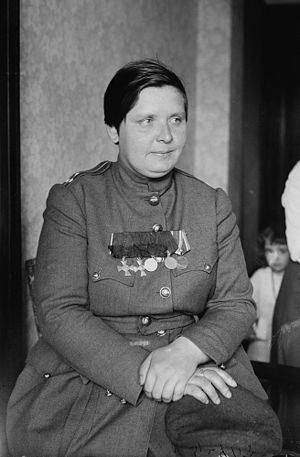- Maria Bochkareva
-
Maria Leontievna Bochkareva (Russian: Мария Леонтьевна Бочкарева, née Frolkova, nicknamed Yashka, 1889–1920) was a Russian woman who fought in World War I and formed the Women's Battalion of Death.
Of a peasant family, Maria Frolkova was born in the Novgorod Guberniya in 1889. She left home aged fifteen to marry Afanasy Bochkarev and they moved to Tomsk, Siberia where they worked as laborers. When her husband began to assault her, Bochkareva left him and entered a relationship with a local named Yakov Buk. She and Buk established a butcher shop, but in May, 1912, Buk was arrested for larceny and sent to Yakutsk. Bochkareva followed him into exile, primarily on foot, and the couple established another butcher shop. Buk was caught stealing again and sent to the remote settlement of Amga in 1913, and once again Bochkareva followed him. Buk began drinking heavily and soon became abusive.
At the outbreak of World War I in 1914, Bochkareva left Buk and returned to Tomsk. In November, she managed to join the 25th Tomsk Reserve Battalion of the Imperial Russian Army by securing the personal permission of Tsar Nicholas II. Men of the regiment treated her with ridicule or sexually harassed her until she proved her mettle in battle[citation needed]. In the following years, Bochkareva was twice wounded and decorated three times for bravery. She bayoneted at least one German soldier to death. (To End All Wars, Hochschild, at 282.)
After the abdication of the Tsar in March 1917, she was charged with creating an all-female combat unit by Minister of War Alexander Kerensky. This was the first women's battalion to be organized in Russia. Bochkareva's 1st Russian Women's Battalion of Death initially attracted around 2,000 women volunteers, but the commander's strict discipline drove all but around 300 dedicated women soldiers out of the unit.
After a month of intensive training, Bochkareva and her unit were sent to the Russian western front to participate in the June Offensive. The unit was involved in one major battle, near the town of Smorgon. The women of the unit performed well in combat, but the vast majority of male soldiers, already long demoralised, had little inclination to continue fighting. Bochkareva herself was wounded in the battle and sent back to Petrograd to recuperate.
Bochkareva was only marginally involved in the creation of other women's combat units formed in Russia during the spring and summer of 1917. Her unit was at the front at the time of the Bolshevik October Revolution and did not participate in the defense of the Winter Palace (this was another women's unit, the 1st Petrograd Women's Battalion). The unit disbanded after facing increasing hostility from the male troops remaining at the front. Bochkareva returned to Petrograd where she was initially detained by the Bolsheviks but released shortly thereafter. She secured permission to rejoin her family in Tomsk, but left for Petrograd again in early 1918. She claims to have then received a telegram asking her to take a message to General Lavr Kornilov, who was commanding a White Army in the Caucasus. After leaving Kornilov's headquarters she was again detained by the Bolsheviks, and after learning her connection with the Whites, was scheduled to be executed. She was rescued, however, by a soldier who had served with her in the Imperial army in 1915 and who convinced the Bolsheviks to stay her execution. She was granted an external passport and allowed to leave the country. Bochkareva then made her way to Vladivostok, where she left for the United States by steamship in April, 1918.
She arrived in San Francisco and then made her way to New York and Washington, D.C, sponsored by the wealthy socialite Florence Harriman. She was given a meeting with President Woodrow Wilson on July 10, 1918, during which she begged the president to intervene in Russia. Wilson was apparently so moved by her emotional appeal that he responded with tears in his eyes and promised to do what he could.[1]
While in New York, Bochkareva dictated her memoirs, Yashka: My Life As Peasant, Exile, and Soldier to a Russian emigre journalist named Isaac Don Levine. After leaving the United States she traveled to Great Britain where she was granted an audience with King George V. The British War Office gave her funding to return to Russia. She arrived in Archangel in August 1918 and attempted to organize another unit, but failed.
In April 1919 she returned to Tomsk and attempted to form a women's medical detachment under the White admiral Aleksandr Kolchak, but before she could complete this task she again was captured by the Bolsheviks. She was sent to Krasnoiarsk where she was interrogated for four months and finally sentenced to execution, found guilty of being an enemy of the people. The Cheka carried out her execution by firing squad on May 16, 1920.
References
- ^ Jerome Landfield to Secretary Breckenridge Long, July 13, 1918. Department of State communique, Long Papers, box 38, Manuscript Division, Library of Congress, Washington, DC.
Botchkareva, Maria. Yashka: My Life as Peasant, Exile, and Soldier. As told to Isaac Don Levine (New York: Frederick A. Stokes, 1919)
Stoff, Laurie. They Fought for the Motherland: Russia's Women Soldiers in World War I and the Revolution. (Lawrence: University Press of Kansas, 2006)
Categories:- 1889 births
- 1920 deaths
- Russian memoirists
- Russian feminists
- People executed by firing squad
- Russian women of World War I
- Russian Provisional Government
- White Russians
- Women in the Russian and Soviet military
- Victims of Red Terror in Soviet Russia
- Executed Russian women
Wikimedia Foundation. 2010.

